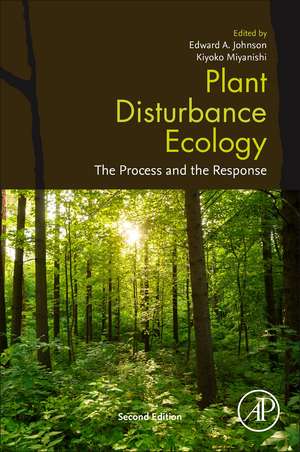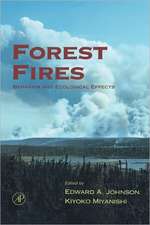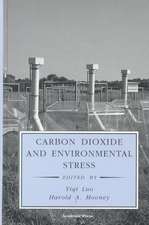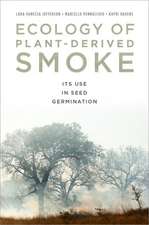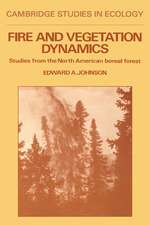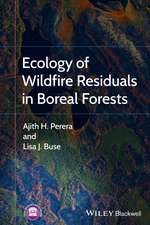Plant Disturbance Ecology: The Process and the Response
Editat de Edward A. Johnson, Kiyoko Miyanishien Limba Engleză Paperback – 20 oct 2020
Plant Disturbance Ecology, 2nd Edition encourages movement away from the informal, conceptual approach traditionally used in defining natural disturbances and clearly presents how scientists can use a multitude of approaches in plant disturbance ecology. This edition includes nine revised chapters from the first edition, as well new, more comprehensive chapters on fire disturbance and beaver disturbance. Edited by leading experts in the field, Plant Disturbance Ecology, 2nd Edition is an essential resource for scientists interested in understanding plant disturbance and ecological processes.
- Advances understanding of natural disturbances by combining geophysical and ecological processes
- Provides a framework for collaboration between geophysical scientists and ecologists studying natural disturbances
- Includes fully updated research with 5 new chapters and revision of 11 chapters from the first edition
| Toate formatele și edițiile | Preț | Express |
|---|---|---|
| Paperback (1) | 692.65 lei 5-7 săpt. | |
| ELSEVIER SCIENCE – 20 oct 2020 | 692.65 lei 5-7 săpt. | |
| Hardback (1) | 551.41 lei 6-8 săpt. | |
| ELSEVIER SCIENCE – 29 apr 2007 | 551.41 lei 6-8 săpt. |
Preț: 692.65 lei
Preț vechi: 880.88 lei
-21% Nou
Puncte Express: 1039
Preț estimativ în valută:
132.54€ • 138.11$ • 109.74£
132.54€ • 138.11$ • 109.74£
Carte tipărită la comandă
Livrare economică 27 martie-10 aprilie
Preluare comenzi: 021 569.72.76
Specificații
ISBN-13: 9780128188132
ISBN-10: 0128188138
Pagini: 562
Dimensiuni: 152 x 229 x 37 mm
Greutate: 0.74 kg
Ediția:2
Editura: ELSEVIER SCIENCE
ISBN-10: 0128188138
Pagini: 562
Dimensiuni: 152 x 229 x 37 mm
Greutate: 0.74 kg
Ediția:2
Editura: ELSEVIER SCIENCE
Public țintă
Academics, graduate students, conservation biologists and land managers interested in plant disturbance ecologyCuprins
1. Disturbance and Succession
2. The Turbulent Wind in Plant and Forest Canopies
3. Thunderstorm Downbursts: Windstorms and Blowdowns
4. Understanding How the Interaction of Wind and Trees Results in Windthrow, Stem Breakage, and Canopy Gap Formation
5. Meteorological Conditions Associated with Ice Storm Damage to Forests
6. The Effect of Icing Events on the Death and Regeneration of North American Trees
7. Coastal Dune Succession and the Reality of Dune Processes
8. Fluvial Geomorphic Disturbances and Life History Traits of Riparian Tree Species
9. Water Level Changes in Ponds and Lakes: The Hydrological Processes
10. Development of Post-Disturbance Vegetation in Prairie Wetlands
11. Modelling fire effects on plants: from organs to ecosystems
12. Insect Defoliators as Periodic Disturbances in Northern Forest Ecosystems
13. Revisiting the Relationship between Spruce Budworm Outbreaks and Forest Dynamics over the Holocene in Eastern North America Based on Novel Proxies
14. Beaver as Agents of Plant Disturbance
2. The Turbulent Wind in Plant and Forest Canopies
3. Thunderstorm Downbursts: Windstorms and Blowdowns
4. Understanding How the Interaction of Wind and Trees Results in Windthrow, Stem Breakage, and Canopy Gap Formation
5. Meteorological Conditions Associated with Ice Storm Damage to Forests
6. The Effect of Icing Events on the Death and Regeneration of North American Trees
7. Coastal Dune Succession and the Reality of Dune Processes
8. Fluvial Geomorphic Disturbances and Life History Traits of Riparian Tree Species
9. Water Level Changes in Ponds and Lakes: The Hydrological Processes
10. Development of Post-Disturbance Vegetation in Prairie Wetlands
11. Modelling fire effects on plants: from organs to ecosystems
12. Insect Defoliators as Periodic Disturbances in Northern Forest Ecosystems
13. Revisiting the Relationship between Spruce Budworm Outbreaks and Forest Dynamics over the Holocene in Eastern North America Based on Novel Proxies
14. Beaver as Agents of Plant Disturbance
Recenzii
"The process by which vegetation changes over time has fascinated plant ecologists for at least a century. Early theories emphasized slow, steady change to a hypothetical stable 'climax' community. By the 1970s, ecologists began to realize that disturbance was the rule, not the exception, and a rather radical shift in thinking about vegetation took hold. This multidisciplinary compendium seeks to move what might be called disturbance science beyond descriptive approaches to look at how particular physical disturbances actually cause particular ecological effects. The many authors cover, e.g., the specifics of how forces like wind (turbulence, microbursts, etc.) can physically cause stem breakage in trees. Other modes of disturbance treated here include ice storm damage to forests and trees; dynamic processes that affect coastal dunes; fluvial processes related to riparian tree growth; the effects of water-level changes in ponds and lakes; heating effects on vegetation; fire's effects on grasslands and trees; a variety of insect impacts on different systems; and the impact of beavers on woody vegetation. The level of technical detail in the chapters varies greatly, and a few rely heavily on mathematical formulas. Other chapters are essentially literature reviews. Plant ecologists with a process- or mechanistically oriented approach to understanding vegetation change will appreciate this book. Summing Up: Recommended. Upper-level undergraduates and above." --CHOICE
